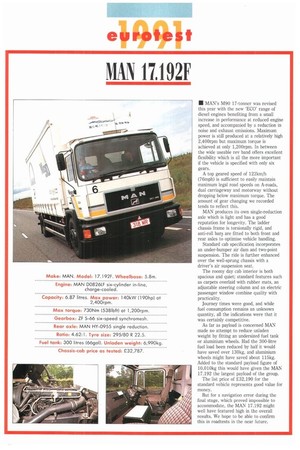MAN 17.192F
Page 36

If you've noticed an error in this article please click here to report it so we can fix it.
• MAN's M90 17-tonner was revised this year with the new `ECO' range of diesel engines benefiting from a small increase in performance at reduced engine speed, and accompanied by a reduction in noise and exhaust emissions. Maximum power is still produced at a relatively high 2,400rpm but maximum torque is achieved at only 1,200rprn. In between the wide useable rev band offers excellent flexibility which is all the more important if the vehicle is specified with only six gears.
A top geared speed of 122km/h (76mph) is sufficient to easily maintain maximum legal road speeds on A-roads, dual carriageway and motorway without dropping below maximum torque. The amount of gear changing we recorded tends to reflect this.
MAN produces its own single-reduction axle which is light and has a good reputation for longevity. The ladder chassis frame is torsionally rigid, and anti-roll bars are fitted to both front and rear axles to optimise vehicle handling.
Standard cab specification incorporates an under-bumper air dam and two-point suspension. The ride is further enhanced over the well-sprung chassis with a driver's air suspension seat.
The roomy day cab interior is both spacious and quiet; standard features such as carpets overlaid with rubber mats, an adjustable steering column and an electric passenger window combine quality with practicality.
Journey times were good, and while fuel consumption remains an unknown quantity, all the indications were that it was certainly competitive.
As far as payload is concerned MAN made no attempt to reduce unladen weight by fitting an undersized fuel tank or aluminium wheels. Had the 300-litre fuel load been reduced by half it would have saved over 130kg, and aluminium wheels might have saved about 115kg. Added to the standard payload figure of 10,010kg this would have given the MAN 17.192 the largest payload of the group.
The list price of £32,190 for the standard vehicle represents good value for money.
But for a navigation error during the final stage, which proved impossible to accommodate, the MAN 17.192 might well have featured high in the overall results. We hope to be able to confirm this in roadtests in the near future.












































































